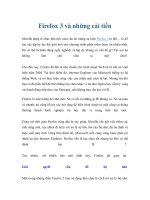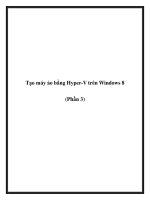Firefox 3 REVEALED phần 3 pot
Bạn đang xem bản rút gọn của tài liệu. Xem và tải ngay bản đầy đủ của tài liệu tại đây (1.31 MB, 10 trang )
17
Firefox 3, on the other hand, actually makes DOM storage support useful, by providing a few other “missing
pieces” necessary to develop offline applications. The first one is a way to identify offline resources via a
cache manifest file, which may look something like this:
CACHE MANIFEST
# v1
# Comments must be preceded by a hash symbol
This manifest file is linked directly in the <html> tag:
<html manifest="
In this way, you can tag resources for offline use: static HTML pages, images, and scripts! Furthermore, by
using the JAR: protocol,
29
it’s also possible to compress scripts to save space (and download time).
Note that as of Firefox 3, offline resources must be listed within the cache manifest, rather than being included
in the page header using <link rel="offline"> or similar. This decision was taken in order to make
Firefox compliant with the actual WHATWG specification.
30
At the moment, Firefox 3 support for offline caching lacks:
■
resource versioning
■
fallback entries
■
opportunistically cached entries
Other than that, everything seems to be on track.
Finally, the navigator.onLine event has been added, which allows a page’s JavaScript code to determine
when the browser is online or offline. One way to make sure you’re offline is to select File > Work Offline,
but it should also be fired when the network connection is lost or not available.
Success stories? Well, there’ s at least one for now: Chris Double added offline support to the Zimbra email
client
31
(a screencast is available
32
).
Now all we need is other browsers to fully embrace the Web Application 1.0 specification and offer similar
support …
29
30
31
32
FREE PDF DOWNLOAD: 101 Ways To Make Money From Your Web Site!
18
Additional HTML 5 and Web Application 1.0 Support
Besides partial support for offline resources, Firefox developers hand-picked a few other interesting HTML
5 features which have been implemented in Firefox 3.
Did you ever try to develop a cross-browser WYSIWYG HTML editor? If you did, chances are that you know
that Firefox offers Midas, a JavaScript rich-text editor.
33
In particular, a collection of DHTML commands
(the same used by IE) have been implemented to perform the most usual editing operations like making
text bold, italic, and so on.
The problem with Firefox versions up to 2 was that we had to display the portion of the page we wanted
the user to edit inside an IFrame, because only the designMode property of the document object was imple-
mented, allowing users to edit a whole document, rather than just a section of it.
But we don’t have to do that any more: it’ s now possible to set the contentEditable property of a particular
HTML element to true to make that element editable. This means, for example, that you can make even a
single div element editable, as shown in the demo by Mark Finkle.
34
The good news is that this function-
ality now works in all major browsers (including Firefox, IE, and Opera).
Other features implemented in Firefox 3 concerning HTML 5 and Web Application 1.0 drafts include:
■
support for document.activeElement and document.hasFocus to determine whether an element has
focus or not
■
support for drag and dragend events to monitor drag-and-drop operations (check out the demo
35
)
■
native support for getElementsByClassName
■
enhanced <canvas> support with new methods to perform transformations
36
and draw text
37
■
support for cross-document messaging via window.postMessage to send string messages across browser
windows (as outlined by a tutorial by John Resig
38
)
■
support for the ping attribute for anchors and area elements; Darin Fisher explains: “When a user follows
a link via one of these tags, the browser will send notification pings to the specified URLs after following
the link.”
39
Unfortunately, the most hyped HTML 5 elements, <video> and <audio>, didn’t make the cut. Chris Double
has reported that he’s still working on them,
40
and that they’re likely to be shipped later on, as they are
marked as a top-priority feature scheduled for Gecko 1.9.1.
33
34
35
36
37
38
39
40
Firefox 3 Revealed (www.sitepoint.com)
19
Still, it must be noted that video and audio support will only be offered for free codecs, like Theora and
Ogg/Vorbis, mainly because of the patent issues associated with proprietary formats like MPEG-4 and MP3.
Improved SVG Support
Firefox supported Scalable Vector Graphics (SVG) since version 2. SVG is an XML-based language used to
represent vector images. Some examples can be found on the W3Schools web site,
41
including the following:
<?xml version="1.0" standalone="no"?>
<!DOCTYPE svg PUBLIC "-//W3C//DTD SVG 1.1//EN"
"
<svg width="100%" height="100%" version="1.1"
xmlns="
<rect x="20" y="20" rx="20" ry="20" width="250" height="100"
style="fill:red;stroke:black;stroke-width:5;opacity:0.5"/>
</svg>
This code, if parsed by an SVG-compatible browser such as Firefox 2 or 3, produces a rectangle with
rounded corners,
42
like the one shown in Figure 9.
Figure 9. The SVG code above renders a rectangle with rounded corners
Arguably, SVG (and SVG manipulation via JavaScript) can be considered a replacement for proprietary
technologies such as Adobe Flash and Microsoft Silverlight, with the important advantages that it’ s an open
standard (SVG 1.1 is a W3C recommendation
43
) in plain text format rather than binary.
Firefox 3 extends Firefox’ s SVG support by implementing the pattern, foreignObject, and mask elements,
and all the filters defined in SVG 1.1 specification.
44
Additionally, a lot of SVG-related bugs have been
fixed in this release, so that it’s now possible to interact in an acceptable way with complex SVG-based
applications such as the Lively Kernel.
45
41
42
43
44
45
FREE PDF DOWNLOAD: 101 Ways To Make Money From Your Web Site!
20
Still, Firefox 3 isn’t as fast as Safari 3 and WebKit at rendering SVG, although it’s definitely faster than
Firefox 2.
Animated PNG Images
Another very important feature related to graphics and animations is native APNG support.
46
A key incentive
for implementing APNG support is to be able to display animation without relying upon Compuserve’s
proprietary Graphics Interchange Format (GIF).
If you were browsing the web in the nineties, you certainly remember those cute but very annoying, poor-
quality GIF animations that plagued the Web. They only had 256 colors, and they didn’t really support
transparency. More recently, they have been rediscovered as throbbers
47
for almost any Ajax web application:
whenever you have to wait for the end of an XMLHttpRequest call, chances are that you’ll see a throbber
spinning to indicate that you have to wait a little longer.
Although GIF animations look ugly for anything more complex than a throbber, APNG images do not. APNG
images are definitely smoother, and they support transparency and 24-bit colors. You can see a few examples
on the Mozilla Labs site, including a spinning version of the Firefox logo in Figure 10.
48
Figure 10. The Firefox logo, an animated version of which appears on the Mozilla Labs site
Unfortunately APNG is only supported by Firefox 3 and Opera 3.5 for now (don’t forget that IE barely
started to support static PNGs with IE7!), so you can’t expect everyone to see your fancy APNG animations
as you intended. The good news is that APNG is fully backwards compatible with PNG, so any browser
that’s able to display PNG correctly (or incorrectly, like IE6 does), will render an APNG animation as a
static PNG.
How do you create APNGs? Well, you can just use the appropriate Firefox Add-on.
49
46
47
48
49
Firefox 3 Revealed (www.sitepoint.com)
21
Microformats
Firefox 3 comes with native Microformats support. That’s good to know, but what does it actually mean?
Microformats, as defined by microformats.org
50
, are:
“[…] a set of simple, open data formats built upon existing and widely adopted standards. Instead of
throwing away what works today, microformats intend to solve simpler problems first by adapting to current
behaviors and usage patterns (e.g. XHTML, blogging).”
More specifically, a microformat is a representation of meaningful information using semantic XHTML and
following a set of rules and conventions. Microformats.org defined a few open standards for microformats,
including:
■
hCard, for people and organizations
■
hCalendar, for calendars and events
■
VoteLinks and hReview, for opinions, ratings and reviews
■
XFN, for social networks
■
rel-license, for licenses
■
rel-tag, for tags, keywords and categories
■
XOXO, for lists and outlines
For example, an hCard looks like this (the example is taken from the Microformats Wiki
51
):
<div class="vcard">
<a class="fn org url" href="
</a>
<div class="adr">
<span class="type">Work</span>:
<div class="street-address">169 University Avenue</div>
<span class="locality">Palo Alto</span>,
<abbr class="region" title="California">CA</abbr>
<span class="postal-code">94301</span>
<div class="country-name">USA</div>
</div>
<div class="tel">
<span class="type">Work</span> +1-650-289-4040
</div>
<div class="tel">
<span class="type">Fax</span> +1-650-289-4041
</div>
<div>Email: <span class="email"></span>
</div>
</div>
If you take a closer look, this is nothing but ordinary XHTML, which follows a set of conventions concerning
nesting, CSS class names, and tag types. As a matter of fact, despite its fancy name, the previous hCard will
be rendered just like ordinary XHTML code.
50
Microformats.org definition of Microformats
51
FREE PDF DOWNLOAD: 101 Ways To Make Money From Your Web Site!
22
This is important because if a developer decided to put an hCard on a page, it would follow the same
standard as other hCards, which would make it easy to parse the hCard data automatically, for example.
To understand what this means, you’d do well to install the Operator extension for Firefox (available since
version 2).
52
Operator is able to parse microformats and present them to the user in an organized way via a toolbar, as
shown in Figure 11.
Figure 11. The Operator toolbar in action
As you can see from Figure 11, the information is still present on the actual web page, but it has also been
parsed by Operator, which enables the user to perform a set of default actions that are available for the
specific information type. In short, as outlined on ReadWriteWeb,
53
Firefox may turn into a sort of inform-
ation broker by using microformats to connect the users to many popular web and desktop services. The
Operator extension is still available, along with a few other ones,
54
so Firefox 3 can parse and display mi-
croformats via extensions, exactly like Firefox 2.
So where’s the long-awaited native support for microformats? Apparently it’ s only under the hood: Firefox
3 exposes a brand new API for parsing microformats using JavaScript.
55
That’s definitely a good thing, but
it’ s a shame that microformats aren’t parsed and rendered in some way natively by the browser. Apparently
this omission was due only to the inability of some of the folks at Mozilla to make up their mind and define
a standard GUI: a lot of ideas were proposed,
56
and a few cool mockups were created, but none made it to
the end product.
Beyond Firefox
Firefox is definitely the most well-known of the Mozilla Foundation’s products, but there are a few other
interesting projects worth keeping an eye on.
Fennec
Fennec
57
is the codename for a new Mozilla project aimed to create a competitive web browser for the
mobile phone market. This is not the first time the Mozilla Foundation attempted to build a mobile browser:
52
53
54
55
56
57
Firefox 3 Revealed (www.sitepoint.com)
23
Minimo
58
actually worked, but compared to competitors such as Opera Mobile and Internet Explorer Mobile,
it’s very slow and heavy on the memory usage—or at least it is on my WM6 phone.
Fennec, on the other hand, aims to become a lightweight, feature-rich, and innovative mobile browser, and
although it’s still in pre-alpha stage, Ars Technica reports that it’s already quite usable.
59
Figure 12 shows
the Fennec browser in action.
Figure 12. Fennec: Firefox for the mobile web
This would be quite an achievement for the Mozilla Foundation, as it would be the first significant free
and open source mobile browser ever made.
Prism
Mozilla Prism
60
is another lesser-known Mozilla project aimed to bring web applications to the desktop.
Essentially, it’s nothing more than a single-tab, extremely minimalist browser which can be used to run
common web applications like Gmail or Google Reader on the desktop.
In its current state, it’s nothing more than a fancy way to create and handle shortcuts to web applications;
those shortcuts, when clicked, will open Prism and load the web address for the web application specified
by the user.
Why bother? Well, it’s a matter of perception more than anything: it’s about having a separate, distraction-
free browser to use just for a single web application. Things will actually become more interesting when
proper support for offline applications is included.
At the moment, there are quite a few interesting features in Prism’s wish list:
61
58
59
60
61
FREE PDF DOWNLOAD: 101 Ways To Make Money From Your Web Site!
24
■
Enable extension support so Prism can be tweaked or enhanced. Also, web apps themselves can be
tweaked via extensions.
■
Add menus for page setup, open profile, and work offline.
■
Add url/domain/subdomain restrictions (external links won’t work).
■
Load “sidebar services.” That is, users have the option to load services that are intended to load in a
sidebar (Google Chat and Google Notebook have specific web pages designed for the sidebar, for example);
such a page will load in Prism as a fixed-size window on the left of the screen.
■
Optionally configure a web app so that it doesn’t share cookies with other web apps in the same Prism.
This could allow multiple Google apps to be open with different accounts (an Gmail account;
a Reader account; and for hosted Gmail).
When those features are implemented, Prism will definitely become more interesting.
Weave
If Prism aims to bring the Web to the desktop, Mozilla Weave
62
is focused on the very opposite: bring your
browser (Firefox) to the Web.
You can think of it as a smart synchronization platform, to synchronize multiple instance of Firefox through
the Internet, in a similar way as Opera Link does.
63
Weave is, as a matter of fact, just an ordinary Firefox extension. All you have to do is install it, register for
an account,
64
and off you go.
At its current stage, Weave gives the user the possibility to synchronize:
■
bookmarks
■
cookies
■
passwords
■
history
■
form data
Compared to Opera Link, which lets you synchronize your bookmarks, speed dial, personal bar, and notes,
Weave seems to be ahead in term of features, and perhaps maturity as well. I have been using it for a few
months, and I must say I’m quite satisfied, even if I hardly use Firefox bookmarks at all.
The aim of this project—to me at least—seems crystal clear: offer such a useful service that it makes you
stick to Firefox for life. That’s how it feels, anyway.
Think about it: Firefox 3 comes with a really fancy bookmarks and history manager, which lets you bookmark
pages with one click and tag them with two. The AwesomeBar lets you search your bookmarks and history
62
63
64
Firefox 3 Revealed (www.sitepoint.com)
25
in a really smart way, and Weave makes sure that wherever you go, you’ll always be able access all the
pages you need quickly.
I must admit that I’m seriously tempted to drop del.icio.us and just start using Firefox Bookmarks instead:
if you use del.icio.us or other social bookmarking services just to store your bookmarks online and make
them available wherever you are, then Weave is ideal.
There’ s only one problem with it: it’ s Firefox-dependent. That’ s the reason why I’m not using it extensively:
I don’t want to become dependent on it, and I don’t want to become dependent on Firefox either! That’s
not because I don’t like Firefox, but because I’m a browser addict and I love experimenting with as many
browsers as possible.
Weave isn’t feature-complete, of course. To be feature-complete, it would have to be able to synchronize
your add-ons, extensions, and themes: at that point, it would become almost irresistible. Imagine the pos-
sibilities for both users and the Mozilla Foundation: Firefox your web platform, wherever you are! Neat,
and scary, too.
The Bottom Line
Firefox 3 is—as with every major release—the best release of Firefox ever. This time, the number of new
features that were released is truly impressive:
■
End users will be pleased to use a much faster and prettier browser.
■
Web developers won’t change the way they develop web sites, but may at least try to experiment with
new HTML 5 elements and features.
■
Extension developers will be able to interact with the browser’ s internals more easily, thanks to the huge
number of new APIs that have been made available (and are fully documented!).
Personally, I felt that this release was focused very much on accessibility, both in terms of user interface
and new developer APIs.
In particular, you can search and filter everything from almost anywhere in the GUI: the Firefox team added
search support to almost every single browser module, and they reduced the number of clicks you need to
use to access certain functions. This is something that is not yet available in other browsers, and is perhaps
one of the most significant improvements on past releases.
The progressive adoption of new standards—and even drafts—is also quite remarkable. As a matter of fact,
Opera is still ahead in this case, but Firefox is catching up quickly.
When it comes to web development, it doesn’t really matter which browser supports more features; the
important consideration is which features are supported by more browsers. For this reason, web developers
will definitely be pleased to hear that they can safely use the contentEditable attribute because it’s sup-
ported by three major browsers, rather than discovering that Firefox only offers embryonic support for offline
applications.
Compared to Opera and Safari, in particular, Firefox is likely to remain a slower and heavier browser, for
a simple reason: its very architecture. Firefox is very open and modular, and allows users to install a
plethora of extensions, while others don’t.
FREE PDF DOWNLOAD: 101 Ways To Make Money From Your Web Site!
26
Opera and Safari are not likely to open up any time soon (even if WebKit, as a matter of fact, is open source),
and they won’t offer extensions either: those, it seems, are unique to Firefox, and will remain so.
It all boils down to what users want. If you want a browser that can be customized in every possible way,
and can become anything you want, from an MP3 player to an FTP client, Firefox is definitely the best (and
the only) choice. On the other hand, if you want “just a browser”, which does its job really well, you may
want to check out Opera and (when it becomes a bit more stable) Safari.
Conclusion
To conclude, I’d like to congratulate everyone who made Firefox 3 possible: developers, testers, and all
active users who “do their part,” in one way or another. It really feels like the Mozilla team is doing its very
best to listen to users and their feedback, and this release is a clear example that open source can still de-
liver the most outstanding software, just the way you want it.
Firefox 3 Revealed (www.sitepoint.com)









